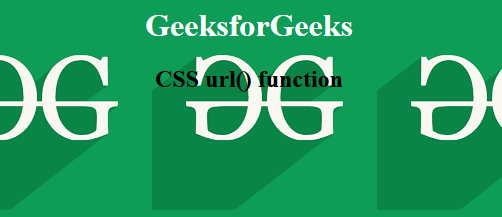CSS url() Function
Last Updated :
15 May, 2023
The url() function is an inbuilt function that is used to include a file. The parameter of this function is absolute URL, relative URL or a data URI. The url() function can be used for background-image, border-image, list-style-image, content, cursor, border-image, border-image-source, src as part of a @font-face block, and @counter-style/symbol.
Syntax:
url( <string> <url-modifier>* )
Parameters: This function accepts a single parameter url which holds the url in string format.
The examples of url are:
<css_property>: url("https://geeksforgeeks.org/image.png")
<css_property>: url('https://geeksforgeeks.org/image.png')
<css_property>: url(https://geeksforgeeks.org/image.png)
Example: Below example illustrates the url() function in CSS:
html
<!DOCTYPE html>
<html>
<head>
<title>CSS url() function</title>
<style>
body {
background-image: url(
text-align: center;
}
h1 {
color: white;
}
</style>
</head>
<body>
<h1>GeeksforGeeks</h1>
<h2>CSS url() function</h2>
</body>
</html>
|
Output:

Supported Browsers: The browsers supported by url() function are listed below:
- Google Chrome 1
- Edge 12
- Internet Explorer 3
- Firefox 1
- Safari 1
- Opera 3.5
Like Article
Suggest improvement
Share your thoughts in the comments
Please Login to comment...